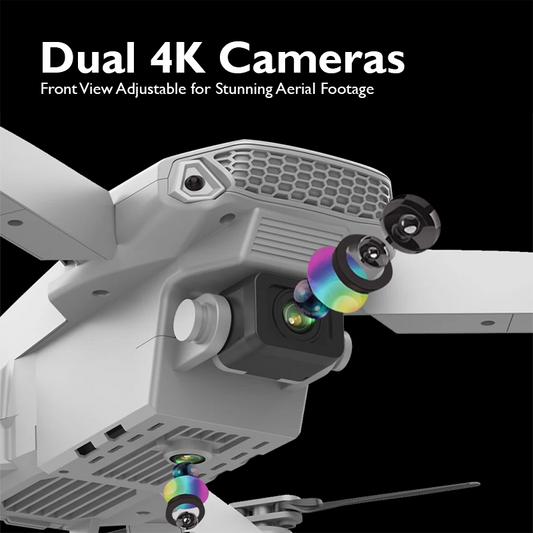Drone Photography in Extreme Conditions: Challenges and Solutions

Drone photography has revolutionized the way we capture stunning aerial shots, offering a unique perspective that was once reserved for the realms of aviation professionals. As enthusiasts and professionals alike push the boundaries of aerial imaging, the demand for drone photography in extreme conditions is on the rise. However, mastering the skies in challenging environments comes with its own set of obstacles. In this article, we'll explore the challenges faced by drone photographers in extreme conditions and discover effective solutions to elevate your aerial photography game.
1.Unpredictable Weather Conditions:

One of the primary challenges faced by drone photographers in extreme conditions is the unpredictable weather. Harsh winds, heavy rainfall, and extreme temperatures can pose serious threats to both the drone and the quality of the shots.
Solution:
Investing in weather-resistant drones equipped with advanced stabilization systems is crucial. Drones designed to withstand adverse weather conditions, such as DJI's Matrice series, are equipped with robust build quality and intelligent flight control systems. Additionally, monitoring weather forecasts and planning your flights during optimal weather windows can significantly mitigate risks.
2.Temperature Extremes:

Extreme temperatures, whether scorching heat or freezing cold, can affect the performance of drone batteries and other electronic components. Operating a drone in temperature extremes can result in reduced flight time and potential damage to sensitive equipment.
Solution:
Opt for lithium-polymer batteries that perform well in a wide temperature range. Before takeoff, allow the drone to acclimate to the ambient temperature to prevent sudden temperature shocks. Keeping spare batteries warm in insulated containers during cold conditions is also a good practice. In extreme heat, consider flying during cooler parts of the day and keeping the drone shaded when not in use.
3.Altitude Challenges:

Drone photography enthusiasts often find themselves exploring elevated terrains, such as mountainous regions. Operating a drone at high altitudes poses challenges related to air density and pressure, affecting both flight stability and battery efficiency.
Solution:
Select a drone model that is specifically designed for high-altitude operations. Drones equipped with altitude-specific flight modes can optimize performance in thin air. Additionally, calibrating the drone's altimeter before takeoff ensures accurate altitude readings, enabling better control and navigation.
4.Limited Battery Life:

Drone photographers often face the dilemma of limited battery life, especially when navigating through challenging terrains or extreme weather conditions. Extended flight times become crucial for capturing the perfect shot without interruptions.
Solution:
Investing in high-capacity batteries and optimizing flight settings can extend the drone's battery life. Carry multiple fully charged batteries for each shoot and plan your flights efficiently to make the most of the available power. Additionally, maintaining batteries at optimal temperatures and avoiding deep discharges can enhance their overall lifespan.
5.Challenges in GPS Signal Reception:

In remote or extreme locations, obtaining a stable GPS signal can be a significant challenge. Poor signal reception can lead to navigation errors, making it difficult to control the drone accurately.
Solution:
Choose drones equipped with multiple GNSS (Global Navigation Satellite System) receivers, as they can connect to a broader range of satellites, enhancing signal reliability. Conduct pre-flight checks to ensure that the drone has a strong GPS lock before takeoff. In areas with weak signals, utilizing alternative navigation methods, such as visual line of sight, can help maintain control.
6.Limited Light Conditions:

Drone photography enthusiasts often seek to capture breathtaking shots during sunrise, sunset, or even in the darkness of the night. However, low light conditions can challenge the capabilities of drone cameras, impacting image quality.
Solution:
Invest in drones with advanced low-light capabilities, such as larger image sensors and adjustable aperture settings. Additionally, using auxiliary lighting equipment, such as drones with built-in LED lights or external lighting attachments, can illuminate the scene and enhance image quality. Experimenting with longer exposure times can also capture more light, resulting in stunning night-time shots.
7.Obstacle Avoidance in Challenging Environments:

Navigating through extreme conditions often means encountering obstacles such as trees, rocks, or buildings. Without effective obstacle avoidance systems, drones are susceptible to collisions, leading to potential damage.
Solution:
Choose drones equipped with obstacle avoidance sensors and intelligent collision avoidance systems. These technologies use sensors, cameras, and algorithms to detect obstacles and adjust the drone's flight path accordingly. Pilots should remain vigilant and monitor the drone's surroundings, especially in challenging environments where obstacles may be less predictable.
8.Legal and Regulatory Challenges:

Operating drones in extreme conditions may involve navigating through various legal and regulatory challenges. Different regions have specific rules and restrictions related to drone flight, and violating these regulations can result in fines or legal consequences.
Solution:
Prior to any drone flight, research and understand the local regulations governing drone operations. Obtain the necessary permits or authorizations if required. Staying informed about airspace restrictions and respecting privacy guidelines is crucial for responsible drone operation. Utilize mobile apps that provide real-time information on airspace regulations and updates.
Drone photography in extreme conditions presents a thrilling opportunity to capture breathtaking images from perspectives previously inaccessible. While challenges are inevitable, understanding and preparing for them can make all the difference. Investing in the right equipment, staying informed about weather conditions, and adhering to legal guidelines are essential steps for mastering the skies. As technology continues to advance, drone photographers can expect even more innovations to overcome the challenges posed by extreme conditions, pushing the boundaries of what's possible in aerial imaging.
Explore a variety of drones at our online drone store.
Happy Flying!











